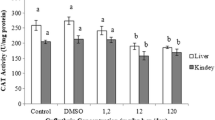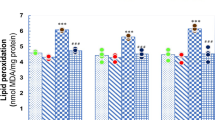Abstract
Oxidative stress by increased production of reactive oxygen species has been implicated in pesticides toxicity. This study focused on the toxicological effects of chlorpyrifos, an organophosphate insecticide and abamectin, a biocide each alone or in combination on antioxidant status, and oxidative stress biomarkers in brain and kidney. Animals were divided into four groups. The first group was used as control while groups 2, 3, and 4 were treated with chlorpyrifos (CPF; 14.9 mg/kg BW), abamectin (ABM; 30 mg/kg BW), and chlorpyrifos plus abamectin, respectively. Rats were treated daily with the tested compounds by oral gavages for 30 days. Results revealed that thiobarbituric acid-reactive substances (TBARS) levels were significantly increased in brain and kidney due to insecticides administration. On the other hand, reduced glutathione (GSH) and protein contents in addition to the activities of antioxidant enzymes, alkaline phosphatase (ALP), and acetylcholinesterase (AChE) were significantly decreased in rat organs. A significant induction in lactate dehydrogenase (LDH) activity, urea, and creatinine levels were also observed. The response was more pronounced in rats treated with both CPF and ABM. Results showed that the used insecticides had the propensity to cause significant oxidative damage in rat brain and kidney which is associated with marked perturbations in antioxidant defense system. It can be concluded that antioxidant enzymes can be used as potential biomarkers of toxicity associated with pesticides exposure.






Similar content being viewed by others
References
Abdel-Daim MM (2014) Synergistic protective role of ceftriaxone and ascorbic acid against subacute diazinon-induced nephrotoxicity in rats. Cytotechnology. doi: 10.1007/s10616-014-9779-z
Abdel-Daim MM et al. (2015) Synergistic ameliorative effects of sesame oil and alpha-lipoic acid against subacute diazinon toxicity in rats: haematological, biochemical and antioxidant studies. Can J Physiol Pharmacol. doi: 10.1139/cjpp-2015-0131
Adedara IA et al (2015) Influence of diphenyl diselenide on chlorpyrifos-induced toxicity in Drosophila melanogaster. J Trace Elem Med Biol 32:52–59
Aebi H (1984) Catalase in vitro. Methods Enzymol 105:121–126, 3rd Ed, Lippincott-Raven publishers, Philadelphia
Agarwal AK (1998) Avermectin. In: Wexler P (ed) Encyclopedia of toxicology. Academic, San Diego, CA, pp 89–90
Aly N, EL-Gendy K, Mahmoud M, El-Sebae AK (2010) Protective effect of vitamin C against chlorpyrifos oxidative stress in male mice. Pest Biochem Physiol 97:7–12
Bagchi D, Bagchi M, Hassoum EA, Stohs SJ (1995) In vitro and in vivo generation of reactive oxygen species, DNA damage and lactate dehydrogenase leakage by selected pesticides. Toxicology 104:129–140
Banerjee BD et al (1999) Biochemical effects of some pesticides on lipid peroxidation and free-radical scavengers. Toxicol Lett 107:33–47
Brown RK, Ricci FM, Ottesen EA (2000) Ivermectin: effectiveness in lymphatic filariasis. Parasitology 121:S133–S146
Cabaud PC, Wroblewski F (1958) Calorimetric measurement of lactate dehydrogenase activity of body fluids. J Clin Pathol 30:234–236
Calviello G et al (2006) DNA damage and apoptosis induction by the pesticide Mancozeb in rat cells: involvement of the oxidative mechanism. Toxicol Appl Pharmacol 211:87–96
Campbell WC (1989) Use of ivermectin in dogs and cats in ivermectin and Abamectin. Springer, New York, pp 245–259
Campbell WC et al (1983) Ivermectin: a potent antiparasitic agent. Science 221:823–828
Cemek M et al (2010) Protective roles of vitamin E (α-tocopherol), selenium and vitamin E plus selenium in organophosphate toxicity in vivo: a comparative study. Pest Biochem Physiol 96:113–118
Chatterjea MN, Shinde R (2002) Text book of medical biochemistry, 5th ed. Jaypee Brothers. Medical Publishers Ltd., New Delhi, p 317
Cully DF et al (1994) Cloning of an avermectin–sensitive glutamate-gated chloride channel from Caenorhabditis elegans. Nature (Lond) 371:707–711
Eissa FI, Zidan NA (2009) Haematological, biochemical and histopathological alterations induced by Abamectin and Bacillus thuringiensis in Male Albino rats. Aus J Basic Appl Sci 3(3):2497–2505
El- Shafey AAM et al (2011) Some physiological and biochemical effects of Oshar extract and Abamectin Biocide on male albino rats. J Am Sci 7(12):254–261
El-Demerdash FM (2007) Lambda-cyhalothrin-induced changes in oxidative stress biomarkers in rabbit erythrocytes and alleviation effect of some antioxidants. Toxicol in Vitro 21:392–397
El-Demerdash FM (2011) Lipid peroxidation, oxidative stress and acetylcholinesterase in rat brain exposed to organophosphate and pyrethroid insecticides. Food Chem Toxicol 49:1346–1352
El-Demerdash FM (2012) Cytotoxic effect of fenitrothion and lambda-cyhalothrin mixture on lipid peroxidation and antioxidant defense system in rat kidney. J Environ Sci Health B47:262–268
El-Demerdash FM, Nasr HM (2014) Antioxidant effect of selenium on lipid peroxidation, hyperlipidemia and biochemical parameters in rats exposed to diazinon. J Trace Elem Med Biol 28:89–93
El-Demerdash FM et al (2013) Kidney antioxidant status, biochemical parameters and histopathological changes induced by methomyl in CD-1 mice. Exp Toxicol Pathol 65:897–901
Ellman GL (1959) Tissue sulfhydryl groups. Arch Biochem Biophys 82:70–77
Ellman GL et al (1961) A new rapid colorimetric determination of acetylcholinesterase activity. Biochem Pharmacol 7:88–95
El-Sheikh EA, Galal AAA (2015) Toxic effects of sub-chronic exposure of male albino rats to emamectin benzoate and possible ameliorative role of Foeniculum vulgare essential oil. Environ Toxicol Pharmacol 39(3):1177–1188
El-Shenawy NS (2010) Effects of insecticides fenitrothion, endosulfan and abamectin on antioxidant parameters of isolated rat hepatocytes. Toxicology in Vitro 24(4):1148–1157
Feig DI et al (2006) Serum uric acid: a risk factor and a target for treatment? J Am Soc Nephrol 17:S69–73
Feng T et al (2008) Effects of trichlorfon and sodium dodecylsulphate on antioxidant defense system and acetylcholinesterase of Tilapia nilotica in vitro. Pest Biochem Physiol 92:107–113
Fetoui H, Garoui EM, Zeghal E (2009) Lambda-cyhalothrin-induced biochemical and histopathological changes in the liver of rats: ameliorative effect of ascorbic acid. Exp Toxicol Pathol 61:189–196
Goel A, Dani V, Dhawan DK (2005) Protective effects of zinc on lipid peroxidation, antioxidant enzymes and hepatic histoarchitecture in chlorpyrifos induced toxicity. Chem Biol Interact 156:131–140
Habig WH, Pabst MJ, Jakoby WB (1974) Glutathione S-transferases. The first enzymatic step in mercapturic acid formation. J Biol Chem 249:7130–7139
Henry RJ, Cannon DC, Winkelman W (1974) Clinical chemistry principals and techniques, 11th edn. Happer and Row Publishers, New York, p 1629
John S et al (2001) Protective effect of vitamin E in dimethoate and malathion induced oxidative stress in rat erythrocytes. J Nutr Biochem 12:500–504
Kale M et al (1999) Lipid peroxidative damage on pyrethroid exposure and alterations in antioxidant status in rat erythrocytes: a possible involvement of reactive oxygen species. Toxicol Lett 105:197–205
Kalender S et al (2005) Diazinon-induced hepatotoxicity and protective effect of vitamin E on some biochemical indices and ultra structural changes. Toxicology 211:197–206
Kehrer JP (1993) Free radicals as mediator of tissue injury and disease. Crit Rev Toxicol 23:21–48
Lankas GR, Gordon LR (1989) Toxicology. In: Campbell WC (ed) Ivermectin and abamectin. Springer, New York
Leve De L, Kaplowitz N (1991) Glutathione metabolism and its role in hepatotoxicity. Pharmacol Therap 52:287–305
Li M et al (2013) Antioxidant response and histopathological changes in brain tissue of pigeon exposed to avermectin. Ecotoxicology 22:1241–1254
Lowry OH et al (1951) Protein measurement with the Folin Phenol Reagent. J Biol Chem 193:269–275
Lu CS (1999) Regulation of hepatic glutathione synthesis: current concepts and controversies. FASEB J 13:1169–1183
Ma J et al (2014) Biochemical responses to the toxicity of the biocide abamectin on the freshwater snail Physa acuta. Ecotoxicol Environ Saf 101:31–35
Mansour SA, Mossa AH (2009) Lipid peroxidation and oxidative stress in rat erythrocytes induced by chlorpyrifos and the protective effect of zinc. Pest Biochem Physiol 93:34–39
Mansour SA, Mossa AH, Heikal TM (2009) Effects of methomyl on lipid peroxidation and antioxidant enzymes in rat erythrocytes: in vitro studies. Toxicol. Indust Health 25:557–563
Maran E et al (2009) Effects of four carbamate compounds on antioxidant parameters. Ecotoxicol Environ Saf 72:922–930
Meister A, Anderson ME (1983) Glutathione. Ann Rev Biochem 52:711–760
Misra HP, Fridovich I (1972) The role of superoxide anion in the autoxidation of epinephrine and a simple assay for superoxide dismutase. J Biol Chem 247:3170–3175
NRA, National Registration Authority (2000) The NRA review of chlorpyrifos, vol. 1
Ohkawa H, Ohishi N, Yagi K (1979) Assay for lipid peroxides in animal tissues by thiobarbituric acid reaction. Anal Biochem 95:351–358
Okahashi N et al (2005) Lack of evidence for endocrine disrupting effects in rats exposed to fenitrothion in utero and from weaning to maturation. Toxicology 206:17–31
Oncu M et al (2002) Nephrotoxicity in rats induced by chlorpyrifos-ethyl and ameliorating effects of antioxidants. Hum Exp Toxicol 21:223–230
Patton CJ, Crouch SR (1977) Spectrophotometric and kinetics investigation of the Berthelot reaction for determination of ammonia. Anal Chem 49:464–469
Principato GB et al (1985) Characterization of the soluble alkaline phosphatase from hepatopancreas of Squilla mantis L. Comp Biochem Physiol B 985:801–804
Rahman MF, Siddiqui MK (2004) Biochemical effects of vepacide (from Azadirachta indica) on Wistar rats during subchronic exposure. Ecotoxicol Environ Saf 59(3):332–339
Ranjbar A, Pasalar P, Abdollahi M (2002) Induction of oxidative stress and acetylcholinesterase inhibition in organophosphorous pesticide manufacturing workers. Hum Exp Toxicol 21:179–182
Sanchez-Hernandez JC, Walker CH (2000) In vitro and in vivo cholinesterase inhibition in Lacertides by phosphonate- and phosphorothioate-type organophosphates. Pest Biochem Physiol 67:1–12
Sancho E et al (1998) Liver energy metabolism of Anguilla anguilla after exposure to fenitrothion. Ecotoxicol Environ Saf 41:168–175
SAS (1986) Statistical analysis system. SAS User’s Guide: Statistics, version 5 Edition SAS Inst., Inc, Cary, NC, USA
Seth V, Banerjee BD, Chakravorty AK (2001) Lipid peroxidation, free radical scavenging enzymes, and glutathione redox system in blood of rats exposed to propoxur. Pest Biochem Physiol 71:133–139
Shakoori et al (1990) Toxic effects of talastar, a new synthetic pyrethroid, on blood and liver of rabbit. Pak J Zool 23:289–300
Sies H (1991) Oxidative stress: introduction. In: Sies H (ed) Oxidative stress: oxidants and antioxidants, vol 23. Academic, San Diego, CA, USA, pp 21–48
Sivakumari K et al (1997) Cypermethrin toxicity: sublethal effect of enzyme activities in a fresh water fish, Cyprinus carpio var. Communis. J Environ Biol 18:121–125
Steel RGD, Torrie JH (1981) Principle and procedure of statistics, 2nd edn. A Biometrical Approach Mc Gvaus-Hill Booh Company, New York, US
USEPA (1986) United State environmental protection agency. Ambient Water Quality Criteria for Chlorpyrifos, Report, US, Washington, DC
Verma RS, Mnugya A, Srivastava N (2007) In vivo chlorpyrifos induced oxidative stress: attenuation by antioxidant vitamins. Pest Biochem Physiol 88:191–196
Yamashita M, Tanaka J, Ando Y (1997) Human mortality in organophosphate poisoning. Vet Hum Toxicol 39:84–85
Yarbrough JD, Chambers JE, Robinson KM (1982) Effect of chronic exposures to pesticides on animal system. In: Chambers JE, Yarbrough YD (eds) Alterations in liver structure and function resulting from chronic insecticide exposure. Raven, New York, pp 25–59
Yu F et al (2008) Apoptotic effect of organophosphorus insecticide chlorpyrifos on mouse retina in vivo via oxidative stress and protection of combination of vitamin C and E. Exp Toxicol Pathol 59:415–423
Author information
Authors and Affiliations
Corresponding author
Additional information
Responsible editor: Philippe Garrigues
Rights and permissions
About this article
Cite this article
Nasr, H.M., El-Demerdash, F.M. & El-Nagar, W.A. Neuro and renal toxicity induced by chlorpyrifos and abamectin in rats. Environ Sci Pollut Res 23, 1852–1859 (2016). https://doi.org/10.1007/s11356-015-5448-9
Received:
Accepted:
Published:
Issue Date:
DOI: https://doi.org/10.1007/s11356-015-5448-9




